The Last Ghost Rocket
December 1957: Nikita Khrushchev claims that the Sputnik 1 launcher decayed over Alaska
See: Ghost Rockets
 |
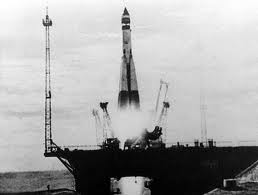
|
Sputnik 1, left Launch of Sputnik 1, right |
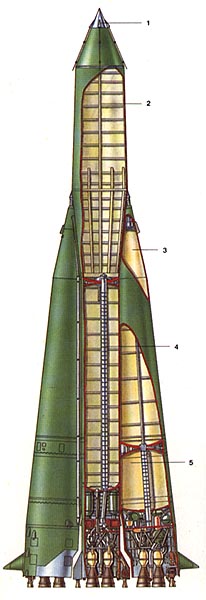 |
|
Sputnik 1 booster at launch, left Booster core stage, right |
Soviet rocket designer Sergei Korolev was determined to make the launch of the world's first artificial satellite a huge technical coup for the Soviet Union. And he succeeded: in addition to the famous 185-pound Sputnik orbiter (1 above, concealed by protective cover), the first Soviet satellite launcher put a substantial portion of itself into orbit. Nearly 100 feet long and weighing about 16,000 pounds, the R-7 launcher's entire "core stage" (right, above) remained in an elliptical orbit for nearly two months after its October 4, 1957 launch, and was designated "Satellite 1957 Alpha-1" by western scientists. Its size made it easy to detect both visually and by radar. The decay of the launcher stage was closely studied and highly anticipated, since it would be the first manmade hardware ever to return to Earth from orbit. (Sputnik itself continued in orbit until early January 1958). The rocket was known to be essentially the same as the Soviet ICBM which had successfully lofted test warheads from Kazakhstan to the Kamchatka peninsula earlier in the year. Its performance and design were objects of intense interest in the west. The rocket's decay occurred on December 1 (GMT) -- but where? The computer and satellite tracking capabilities of both the US and USSR were still rudimentary and the reentry dynamics of such a large, tumbling object were full of unknowns, so there was much ambiguity about the exact location of the reentry.
Soviet Premier Nikita Khrushchev made headlines on December 7 by insisting that the rocket had "fallen in the US." When asked by reporters if he meant that the rocket had burned up over US territory, Khrushchev insisted that he meant that parts had landed on US soil:
"We know it fell on the United States, " he said. "But they do not want to give it back to us."
"Apparently part of it fell on the United States," he said, when asked whether he did not mean that it had perhaps disintegrated in flames over the United States. He also said, in answer to a clarifying question, that when he used the word "America" he meant the United States and not part of the American Continent. When this correspondent asked whether he was really serious or merely joking, Mr. Khrushchev replied: "I was absolutely serious." "We relied on them," Mr. Khrushchev said of the United States, "trusting in their decency, but they did not live up to it."
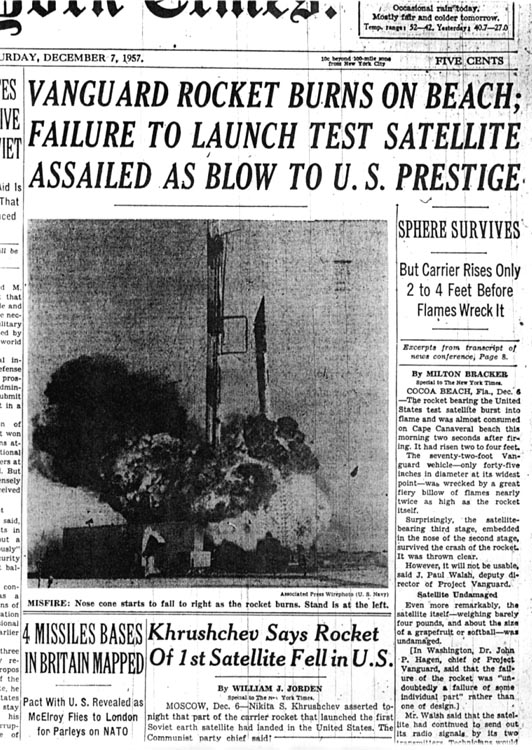
The following day the Soviet Academy of Sciences issued a formal appeal to the US to return the debris.
The Soviet scientists reported on the destruction of the rocket carrier without qualification. They did not give their sources, but said that "according to available data remnants of the rocket carrier fell on the west coast of North America." Tonight Tass, the official Soviet news agency, declared that the rocket's decline became obvious last Saturday. Its fall toward the earth became "especially intensive," it said on Sunday while it was passing over the city of Irkutsk, the Chukchi Peninsula in Siberia, and Alaska and further along the west coast of North America.
The Academy's appeal tonight was more formal [than Khrushchev's]. It requested the rocket remnants and available data in the interests of science.
The same edition of the New York Times confirmed that the US Army actually had searched for the rocket in Alaska on December 1:
The Defense Department asked the Army today to check a rumor that the Soviet rocket had fallen in Alaska. Reports that it had dropped in an area about 100 miles southeast of Fairbanks reached Army circles in Alaska last Sunday. However, scientists there immediately discounted them, saying a large meteor had presumably given rise to the rumors.
The Army last week ordered a search near Fort Greely Reservation, 100 miles southeast of Fairbanks, for an unidentified flying object believed to have landed there. The hunt was called off. An Army spokesman in Alaska said heavy snowfall in the area had been a factor in abandoning the search.
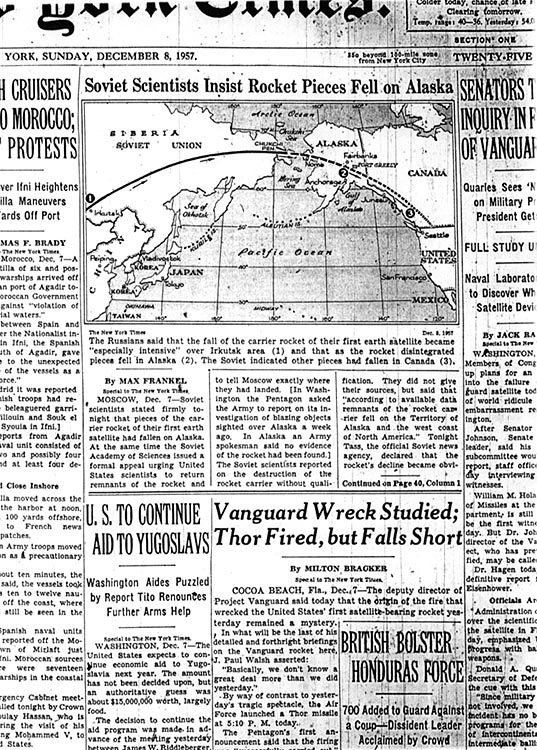
US authorities from the White House to the State Department to the Pentagon unanimously denied knowledge of any such recovery.
Astronomer Fred Whipple of the Smithsonian Astrophysical Observatory, Cambridge, Massachusetts, had been studying the descent of Satellite 1957 Alpha-1 for weeks and denied the Soviet claims. Whipple and J. Allen Hynek, director of SAO's "Project Moonwatch" satellite tracking program (which was originally designed to observe the US Vanguard satellite) are shown below plotting Sputnik's orbit.
See: Project Moonwatch (external site)
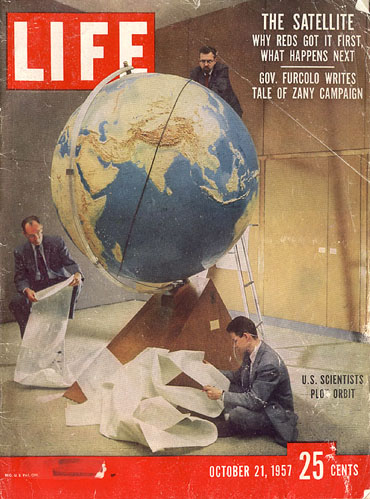
On December 7, Whipple told the New York Times that he had "nothing more to add" to his earlier statement that the rocket had decayed far from US territory.
"I have been in contact with scientists in Alaska and they reaffirm that reports of falling objects the day the rocket was believed to have crashed to earth were definitely fireballs"...
Dr Whipple had stated earlier that it was his belief that the rocket carrier had fallen over "the eastern Pacific, the South Seas, the Indian Ocean or continental Asia."
A formal US report issued a few months later contained the following map and asserted that the rocket had decayed on revolution 880, which passed west of North America.
See: Project "Harvest Moon" analysis of reentry of Satellite 1957 Alpha-1
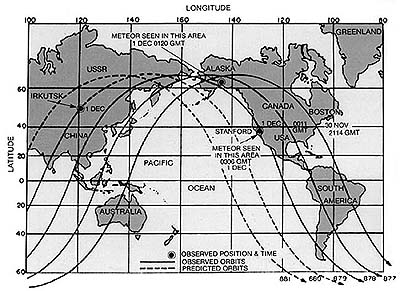
Ironically, the spectacular failure of the first US satellite launch attempt on December 6 may have overwhelmed the significance of Khrushchev's statement, and the "crash-retrieval" flap quickly disappeared from the major newspapers.
However, in Alaska the story was anything but cold. Reporters in Fairbanks were discovering that the Army had called in eyewitnesses who believed they had seen the Sputnik rocket's fiery descent near the US Army's remote Gerstle River Test Range (an arctic biological and chemical warfare test facility under authority of the Dugway Proving Ground) southeast of Fort Greely. They also learned that the Army continued to search for possible debris for at least a week after the reported fireball sightings on the afternoon of December 2 (local time).
And in classic manner, the eyewitness accounts of the suspected rocket fireball manifested in the form of typical UFO reports:
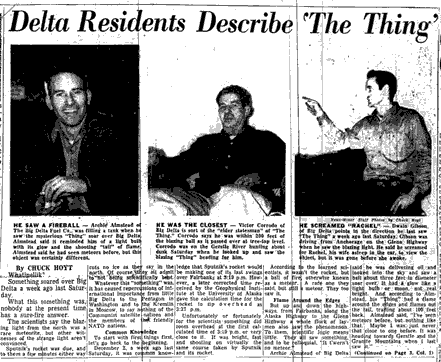 |
click to enlarge |
Fairbanks Daily Newsminer, Dec 10, 1957
Delta Residents Describe 'The Thing'
By Chuck Hoyt
Whatinellnik?
Something soared over Big Delta a week ago last Saturday.
What this something was, nobody has a sure-fire answer.
The scientists say the blazing light from the north was a rare meteorite, but other witnesses of the strange light aren't convinced.
Sputnik's rocket was due, and to them a few minutes either way cuts no ice as they say in the north. Of course, they all admit to not being scientifically bent.
Whatever this "something" was, it has caused repercussions of international importance from little Big Delta to the Pentagon in Washington and the Kremlin in Moscow, to say nothing of the Communist satellite nations and the members of the friendly NATO nations.
COMMON KNOWLEDGE
To start with first things first, let's go back to the beginning.
December 2, a week ago last Saturday, it was common knowledge that Sputnik's rocket would be making one of its last swings over Fairbanks at 3:19 p.m. However, a later corrected time received by the Geophysical Institute at the University of Alaska gave the calculation time for the rocket to zip overhead at 3:37 p.m.
Unfortunately or fortunately for the scientists something did zoom overhead at the first calculated time of 3:19 p.m. or very close to it. It was bright, fast and shooting on virtually the same course taken by Sputnik and its rocket.
According to the learned scientists, it wasn't the rocket, but a ball of fire, otherwise known as a meteor. A rare one they said, but still a meteor. They too saw it.
FLAME AROUND THE EDGES
But up and down the highways, from Fairbanks, along the Alaska Highway to the Glenn Highway a whole flock of laymen also saw the phenomenon. To them, scientific logic means little. They all saw something, and to be colloquial, "It t'wernt no meteor."
Archie Almstead of Big Delta said he was delivering oil and looked into the sky and saw a ball about three feet in diameter [sic] soar over. It had a glow like a light bulb or moon, not real bright. And according to Almstead, his "Thing" had a flame around the edges and flames out the tail, trailing about 100 feet back. Almstead said, "I've seen meteors before, but nothing like that. Maybe I was just never that close to one before. It was heading towards Gerstle and the Granite Mountains when I last saw it."
Another witness was Dwain Gibson, a carpenter from Big Delta. Gibson was returning from a Thanksgiving holiday in Anchorage when he saw the strange light in what he later judged to be the Gerstle area. He was approximately 25 miles from Glenallen on the Glenn highway when he saw the object.
IT WAS DULL RED
Gibson said, "I was driving along coincidentally thinking of seeing Sputnik's rocket when off to my left I saw this object. I hollered to my wife Rachel and my brother who were both asleep in the car, but by the time they awoke it was gone."
According to Gibson's version, it was a dull red when he first saw it and it seemed to get lighter as it went over the horizon or came closer to the earth. It was round and it didn't have a tail. "I have seen meteors before, so was sure it was either Sputnik or its rocket," he said.
Gibson added, "It looked to me like just as it was about to hit, or go over the horizon it just went out. It didn't explode or nothing."
PERFECTLY ROUND
Asked whether he thought what he saw was Sputnik's rocket, Gibson said, "I don't think it was a star and I don't think it was a meteor. It was perfectly round. I'd sure like to take a tour looking for it."
"I'd like to get into a plane and go down to where I saw it and then fly on a direct course to where I last saw it. I think the same thing should be done from the University of Alaska where the scientists saw the object and also from where Vic Corrodo on Gerstle saw it. That way it could be pin-pointed pretty good."
HUNTER WAS CLOSEST
The closest viewer of the object however, was Victor Corrodo, who with two companions was hunting moose on the Gerstle River.
Corrodo said, "We- Ken Taylor, Sgt. Bob Medford and I - drove a jeep up the river. It was getting dark and we were returning. I was walking ahead of the jeep scouting for moose. All of a sudden I looked up and saw this thing right in front of me. It was cutting the treetops. It was going so fast that when I turned around to see where it was, it was gone.
"I didn't have to raise my head to see the thing. It was about 200 feet from me and making a whistling noise when it went by - something like a fan. I never heard it hit," he said. "I was more anxious to see where it fell."
Corrodo added, "It was a big round object, but at first it looked oblong and then round and shiny and sort of milky white with little flames, both reddish and bluish."
TUMBLED THROUGH SPACE
The most outstanding thing about "The Thing," Corrodo said, was that it appeared to be revolving or tumbling through space.
Since that time, Corrodo says he has been "hounded to death" by press associations throughout the country, scientists and the Army at Fort Greely who conducted the search for the object.
Saturday night, he and other residents of the area who saw the object were called to a meeting at Fort Greely to be further interrogated by Army officials and scientists from the University of Alaska.
DAILY SEARCHES
According to Army public information officials at Fort Greely, the search for the object was called off because of a deep snow fall in the general area.
However, it was learned by this reporter that the snowfall in the area where Corrodo sighted the object hasn't been severe and that also daily searches for the object were still being made.
But regardless, if it wasn't Sputnik's rocket and it wasn't a meteor - whatinellnik was it?